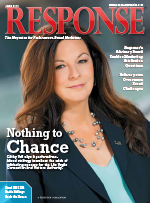 About two weeks back, Response‘s August issue hit the web (and, since, most subscribers’ mailboxes). Yesterday, we wrapped up and sent our September issue to print. So today I’m taking a few minutes out of the day to get this post up and share some back story on the August pub, which is fronted by our cover story on global cosmetics brand Kiko Milano. The issue also features our annual look at the financial services marketplace, a story on how the marketers behind no! no! battled counterfeiters and won, and a feature touching on the latest trends affecting payment processing. Here’s more on each of those stories — and others:
About two weeks back, Response‘s August issue hit the web (and, since, most subscribers’ mailboxes). Yesterday, we wrapped up and sent our September issue to print. So today I’m taking a few minutes out of the day to get this post up and share some back story on the August pub, which is fronted by our cover story on global cosmetics brand Kiko Milano. The issue also features our annual look at the financial services marketplace, a story on how the marketers behind no! no! battled counterfeiters and won, and a feature touching on the latest trends affecting payment processing. Here’s more on each of those stories — and others:
- I first met Igor Credali, New York-based e-commerce leader of Kiko Milano’s U.S. expansion efforts, at the eTail West event in Palm Desert, Calif., about six months ago. I’d received outreach from digital partner Linc for a meeting at the event, and during that meeting, the Linc team introduced me to Credali as one of its “star” clients. The story about Linc’s efforts to help Kiko build its brand in the U.S. — a brand that is extremely well known and regarded throughout Europe — was intriguing. When I returned to the office and started digging deeper on Kiko’s work in the U.S. — it’s online marketing efforts and rapid ascension in brick-and-mortar retail — I knew this was a story we wanted to tell. Fortunately, the crew at Linc and Credali himself were up for the idea. If you missed it above, here’s the link: A Beautiful Expansion
- Another annual staple, our feature on the latest trends for financial services marketers takes a deeper look at the different variations of media — style, content, length, and more — that marketers in the banking, insurance, and finance worlds are using to reach consumers. For years now, financial services marketers have been pathfinders, leading the way for other verticals in showing how offline and online media can converge to drive response from consumers. That’s still true today. What are they up to now? If you missed the link above, click here to check out the story: The Dollars and Cents of Performance-Based Marketing
- An interesting partnership between skin-care marketer Radiancy and leading e-commerce websites is at the heart of a feature that shines a spotlight on the ongoing problem of counterfeit products. At our DRMA Winter Bash last December in New York, I met Jaimee Given, Radiancy’s marketing manager, who shared openly about the struggles the company was facing with counterfeit versions of its popular no! no! product — especially on websites like Amazon, eBay, and Alibaba. She was working hard at solving the issue and had enlisted leaders from those e-retailers and more for help. The story you see in this issue talks about the incredible results Given and Co. have authored — as well as discussing the landscape going forward. Our Doug McPherson has the story: Beating the Bad Guys
- The concepts behind processing consumer payments seem to be changing as quickly, at the least, as the outlets where consumers can buy marketers’ products and services. Along with growing e-commerce — and, perhaps more strikingly, m-commerce (mobile commerce) — marketers must continue to address customer concerns about security and privacy. And with new EMV chip cards becoming the norm, online fraud has become even more prevalent. What does it all mean? We asked a trio of payment processing experts about these items and more. Here’s what they had to say: Pay Day
- Our monthly direct response TV and radio media billings return to the short-form DRTV space for first-quarter 2016 results. Once again — and hopefully for the fourth and final time since they were announced — Kantar Media’s changes to its Hispanic media measurements affect its reported results. Another slide — more than 25 percent — left short-form DR results at what we hope is a new 1Q baseline: $622.4 million. For a full look at 1Q 2016 short-form DRTV media billings, click here: No New Tale to Tell for Short-Form DRTV
- Other key items in this month’s issue include:

- A DRMA Spotlight story on Georgia-based a2b Fulfillment
- A solid column from Motivational Fulfillment‘s Andrea Stuhley on how brick-and-mortar retailers are embracing e-commerce
- A photo recap of our July 27 DRMA Summer Bash in Irvine, Calif., highlights this month’s “But Wait, There’s More” page
- Finally, sometimes when working on my Editor’s Note column, timing is everything. Just days before I sat down to write my monthly missive, two massive deals shook the performance-based marketing world: Unilever‘s $1 billion purchase of Dollar Shave Club; and Verizon‘s $4.8 billion deal to acquire Yahoo. Want to talk about a lay-up? These two deals — and how they each spoke to the growing importance of how marketers are quantifying spend and success — were prime fodder to write about. If you missed the link above, here you go: Verizon-Yahoo, Unilever-Dollar Shave Club Speak to Performance-Based Power
Thanks again for reading and interacting with Response!

